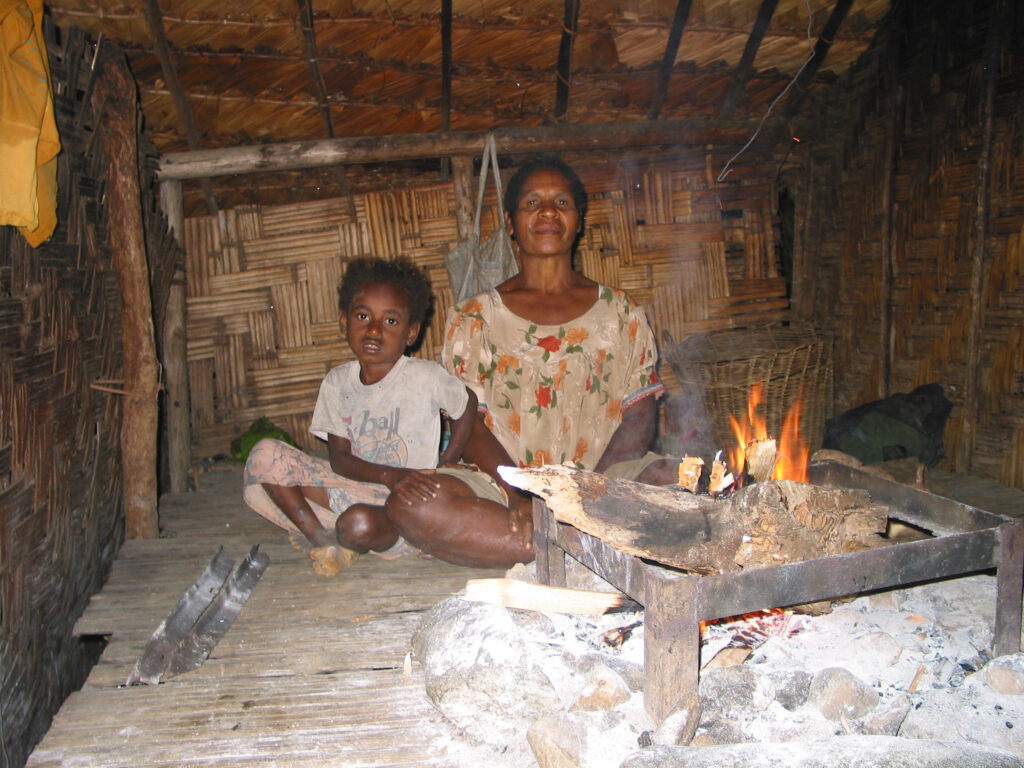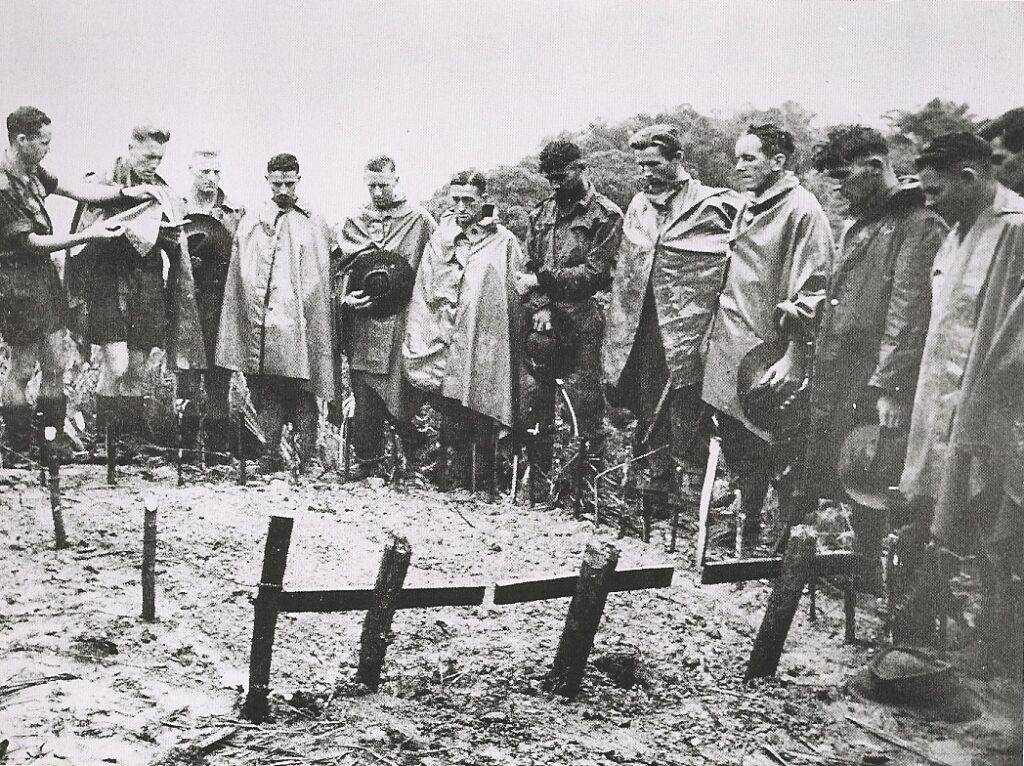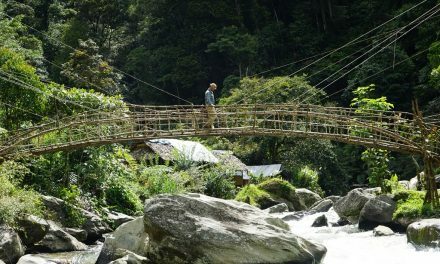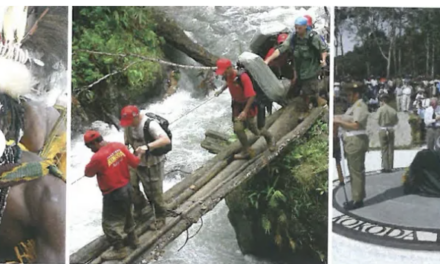This content has been archived. It may no longer be relevant
The illegal blockade on the Kokoda Trail should be the catalyst for an inquiry into the operation of the DFAT Kokoda Initiative management system which has resulted in a 41 percent fall in the number of Australians trekking Kokoda since they assumed control of the PNG Kokoda Track Authority in 2009.
A threat to mine part of the Kokoda Trail in 2006 caused Australia to rush into establishing a well-intentioned ‘Joint’ Understanding with the PNG government to ward off future threats from miners and loggers through the development of a World Heritage nomination ‘for the Kokoda Track and Owen Stanley Ranges’.
Responsibility for the agreement was delegated to the ‘Department of Environment, Water, Heritage, and the Arts’ due to their responsibility for overseas sites of historic interest to Australia. Soon after ‘Heritage’ was dropped from their title, and it was rebadged as the ‘Department of Sustainability, Environment, Water, Population, and Communities’ (DSEWPC).
The Department of Veterans Affairs, which is responsible for the commemoration of our military heritage was not included in the drafting of the ‘Joint’ Understanding and has been sidelined ever since.
Environment officials, with no understanding of Papua New Guinea, pilgrimage tourism, or the Principles of Commemoration were dispatched to Port Moresby to help ‘save’ the Kokoda Trail.
It was soon evident that they lacked expertise in commercial business management and were unfamiliar with the ‘Melanesian Way’ which has been infected with endemic corruption in recent years. As a result, Kokoda tourism, which generates around $20 million (PNGK50 million) for PNG each year, has since fallen by 41 percent.
This computes to a cumulative loss of almost $20 million (PNGK50 million) in foregone wages, campsite fees and local purchases for subsistence village communities we have spent more than $65 million (PNGK170 million) trying to help!
The fall in trekker numbers was due to the focus on a World Heritage nomination at the expense of our shared military heritage across the Kokoda Trail.
Poor governance practices that would not escape scrutiny from anti-corruption bodies in Australia are now evident in the DFAT funded Kokoda Initiative in PNG.
Australian officials soon learned their PNG counterparts will support any proposal that has the prospect of an Australian Aid dollar attached to it. This allows them to subtly use ‘aid-for-influence’ and deflect criticism of their failures by declaring ‘this is what PNG wants!’.
It is now clear that the word ‘Kokoda’ has been hijacked to give relevance to socio-environment issues that would otherwise fail the test of relevance in regard to the expenditure of taxpayers funds on their ‘Kokoda Initiative’.
These failures, at the expense of our wartime heritage and the subsistence villagers we are supposed to be helping, can no longer be ignored. They include:
- Their failure to conduct a single village-based workshop to determine local needs;
- their failure to introduce a single management system for Kokoda tourism – after 15 years insitu it is still not possible to book a campsite anywhere across the Trail;
- Their failure to assist in the development of any campsites – or to even build a single hygienic toilet anywhere across the 138 km length of the Trail;
- Their failure to develop an ‘Environment Management Plan’ for the Trail;
- Their failure to install a single ‘environmental interpretation sign’ anywhere along the Trail’
- Their failure to develop a Joint Agreement to commemorate our shared military heritage;
- their failure to develop a credible Military Heritage Master Plan for the Kokoda Trail;
- the engagement of consultants to report on issues unrelated to pilgrimage tourism;
- their pursuit of mythical ‘lost battlefields’;
- the exposure of their ‘World Heritage’ fallacy;
- their failure to conduct proper cost-benefit analysis for aid-funded projects across the Trail;
- their failure to publish annual financial reports;
- improper practices in the awarding of Government contracts;
- improper transfers of KTA funds to an Australian NGO; and
- the whitewash of ‘mateship’ from our Kokoda story in their current ‘Joint Agreement’.
The ‘Joint Understanding between PNG and Australian on the Kokoda Track and Owen Stanley Ranges’, signed in 2008, is no longer relevant due to:
- the opening of a Chinese funded $260 million dam on the Brown River (the Edevu Hydro Project) which has negated the need ‘to maintain the Brown River Catchment, given its national importance as a potential water and power supply from Port Moresby’[ii]; and
- A recent expert review of the tentative listed sites for World Heritage in Papua New Guinea which concluded that the Interim Protection Zone (IPZ) developed by the Kokoda Initiative ‘has little prospect of being able to stand alone as a World Heritage nomination, at least on natural heritage values. Given the on-going threat to heritage values by mining and other development activities, no part of the Kokoda Track and Owen Stanley Ranges Tentative Listed area should be considered for formal nomination as a World Heritage area . . . ’[iii]
It is therefore time to reset our Joint Understanding by separating ‘military heritage’ from ‘environment’!
The Kodu Goldmine on Mt Bini
After the official opening of the Isurava Memorial on the 60th anniversay of the battle in 2002 the Department of Veterans Affairs moved on and displayed no further interest in developing the Kokoda Trail as a pilgrimage tourism destination.
This attitude changed after the discovery of a gold mine at Kodu on Mt Bini adjacent to the southern slopes of the Kokoda Trail.
Soon after bulldozers moved in Australian lawyers were engaged to thwart the approval process – environment officials were mobilised to assist PNG in developing a World Heritage listing for the Kokoda Trail and surrounding Owen Stanley Ranges to prevent any furhter incursions from miniing and logging.
This led to an influx of officials and consultants from the fields of environment, anthropology, archeology, and social engineering – military heritage experts were not incluced.
The Kokoda Trail has since been managed as an environment park rather than as a pilgrimage tourism destination based on the wartime heritage of the Kokoda campaign.
An ongoing grievance with the compensation awarded to landowners of the Kodu goldmine, along with a fall of 41 percent in the number of trekkers as a result of dysfunctional management system imposed on the PNG Kokoda Track Authority, led to a blockade by the Kodu landowners 18 years later and the closure of PNGs most popular tourims destination in September 2024.
In retrospect, village communities would have been far better off under the proposals put forward by the mining company, Frontier Resources, and trekker numbers would have continued to grow if Kokoda tourism had been professionally managed as a commercial tourism enterprise for the economic benefit of the traditional landowner communities across the Trail.
The following links provide background to the closure of the Trail due to Canberra’s failure to settle the compensation issue and to effectively manage the Kokoda Trail:
- The Mt Kodu Goldmine
- The Kodu Goldmine: Facts, Fallacies and Fabrications
- Illegal Kokoda Blockade – Timeline and consequences for Kokoda Tourism
- Kokoda Tourism: The cost of anarchy
- Proposed resolution to the illagal Kokoda blockade
PNG Kokoda Track Authority (KTA)
The Kokoda Track (Special Purpose) Authority (KTA) was proclaimed by the Minister for Provincial and Local Government Affairs, Sir Peter Barter MP in 2004.
The purpose was to manage the increasing number of trekkers and ensure traditional landowner communities received shared benefits from the emerging Kokoda tourism industry. A former ‘Kiap’, Mr. Warren Bartlett was appointed to manage the KTA on a salary of $12,500 with a part-time assistant. During his tenure as KTA CEO trekker numbers increase by 255% frpm 1,584 in 2004 to 5,621 in 2008 and the Kokoda Trail emerged as PNGs most popular tourism destination.
Australian environment officials took control of the Kokoda Trail under a Joint Understanding with PNG in 2009 after a threat to develop a goldmine on an adjacent range was averted through an intervention by the Australian Government. There was almost a 10-fold increase in staff, and a multi-million-dollar aid budget was allocated.
Since then, the organization they put in place has been corrupted – trekker numbers have fallen dramatically by 41% from 5,621 in 2008 to 3,308 in 2023 under their watch due to their priority of managing the Trail as an environment park rather than as a tourism enterprise.
The following links record the factors leading to the demise of Kokoda tourism under the influence of the DFAT-Kokoda Initiative:
- Chronology of facts regarding the Kokoda Trail
- The Kokoda Trail: Chronology of Mismanagement: 2009-2019
- Database evaluation of Kokoda Tourism: 2003-2019
- Kokoda Trail Strategic Plan: 2012-2015 – Fail!
- Response to the 2019 KTA Forum Minutes
- Call to cancel Kokoda Track Authority Junket to Brisbane
- National Court Restores Adventure Kokoda Tour Operator License
DFAT ‘Kokoda Trail Manager’ Links:
The PNG KTA CEO and his part-time assistant were overwhelmed in trying to administer 5.621 trekkers in 2008 – Australians who paid for trek permits in the expectation of safe passage and adequate campsite facilities were left to their own resources as chaos prevailed on the Trail.
Kokoda tour companies, desperate for an orderly managed system, welcomed the news that Australian officials would assume control of the Kokoda Track Authority in 2009.
The first manager was a female DEI appointment, Annette Dean. Those familiar with the social-cultural environment in Boroko at the time would have advised it was not a suitable or safe place for an Australian woman to work. It was no surprise that Ms. Dean soon required a security guard to escort her between the carpark and her office each day. Apart from a few emails, she also failed to engage with Kokoda tour operators who had been trekking Kokoda for 18 years prior to her arrival. She seemed to be overwhelmed and returned to Australia soon after.
Dean was replaced by Rod Hillman who had a background in evironmental management but did not have any commercial business management qualifications or any experience in military heritage or pilgrimage tourism. But more importantly he had no knowledge of the Melanesian Way as it was his first trip to PNG.
Hillman used traditional bureaucratic strategies of conducting endless meetings, forums and workshops and publishing glossy brochures to create an impression of busyness – however the record shows there were no outcomes from any of them.
His legacy document was the development of a KTA Strategic Plan: 2012-2015 – an impressive PR exercise however not one of the five strategies or 33 objectives were achieved. It was quietly shelved in 2015 after Hillman had returned to Australia and the chaos managment system across the Trail prevailed.
The following links provide an overview of the outcomes of the Annette Dean – Rod Hillman era of management:
DFAT ‘Kokoda Initiative Advisor’ Links:
Mark Nizette, a senior bureaucrat from the Department of Sustainability, Environment, Water, Population and Communities (DSEWPC) in Canberra, was assigned as a ‘Management Advisor’ to the PNG Department of Environment and Conservation in August 2011 – he was employed within the PNG Conservation Environment Protection Agency (CEPA).
His status was later updated to ‘Strategic Advisor’ to the DFAT Kokoda Initiative which operated under his influence from 2011 – 2023.
It’s not known what ‘strategic advice’ Nizette provided regarding the management of the Kokoda Trail as there is not a single management protocol in place – so the ‘law of the jungle’ prevails today just as it did when he was appointed in 2011!
It’s not known what ‘strategic advice’ Nizette provided regarding the protection and interpretation of our military heritage across the Trail because not a single aid-dollar has been invested in any battle site between Owers Corner and Kokoda during his 12-year tenure.
It is not known what ‘strategic advice’ Nizette provided regarding the protection and interpretation of the environment across the Trail because there is no environmental management plan in place, and not a single environmental interpretation sign has been installed anywhere along its 138 km length.
It is not known what ‘strategic advice’ Nizette provided regarding the development of campsites to meet trekkers needs as there is not a single hygienic toilet anywhere across it – most trekkers now ‘go bush’ which is the worst environmental outcome because of the resultant pollutiom.
It is not known what ‘strategic advice’ Nizette provided to assist village communities to earn additional income from Kokoda tourism as there is no evidence of a single ‘micro-business’ or ‘micro-finance’ initiative being introduced during his 12-year tenure.
It is not known what ‘strategic advice‘ Nizette provided regarding investment in aid-funded projects across the Trail as ‘village-museums and trade centres’ sit empty; school classrooms are under-utilised due to a lack of teachers and students; and health centres lack trained staff and regular supplies of medicine.
The only measure of Nizette’s success or otherwise are Kokoda Track Authority records which show that under PNG management 5,621 trek permits were issued in 2008 – the following year, under DFAT-Kokoda Initiative management the number of trek permits fell to 4,364.
The first full year after Mark Nizette arrived as ‘Strategic Advisor’ in 2012, the number of trek permits issued continued to fall to 3,597. By the time Nizette returned to Australia in 2023, after 12 years as ‘Strategic Advisor’ and a multi-million-dollar aid-budget to support his ‘Kokoda initiatives’, the number of trek permits issued had fallen further to 3308!
- Mark Nizette MBE – Strategic Advisor or Foreign Influencer?
- Call for investigation into the recruitment process for the engagement of a National Military Heritage Advisor in PNG
- The Fallacy of a Lost Battlefield on Kokoda
- The Fallacy of World Heritage for the Kokoda Trail
- Review of the Kokoda Initiative Master Plan
- Review of the Mid-Term Review of the Kokoda Initiative 2nd Joint Understanding
- Response to the 2018 KTA Review by Tourism Recreation Conservation Consultants
- Kokoda Initiative Annual Report 2019 – A betrayal of our Kokoda Legacy
- Legislation for new entity to manage Kokoda underway
- Review of Nizette’s proposed DFAT Kokoda Track Management Authority Act
Village-Based Workshop Links:
Prior to the public outcry over the development of a goldmine adjacent to the southern section of the Kokoda Trail in 2006, Veterans Affairs ministers and their departmental advisors had no interest in the Kokoda Trail – I have an abundance of corresopondence between 1992 and 2002 to support this statement.
Their apathy motivated us to establish a Kokoda Track Foundation to raise the necessary funds to develop a strategic plan which we could present to the PNG Government – the plan involved the conduct of village-based workshops so we could better understand the needs of traditional landowner communities.
The following links detail the process we used to develop our strategic plan which we presented to PNGs Grand Chief and Prime Minister, Sir Michael Somare MP, at the Airways Hotel on 30 June 2006 – along with a record of the workshop we conducted at Efogi village which we hoped would be a template for further development.
- The Kokoda Track Foundation: 2003-2006
- Template for the conduct of village-based workshops across the Kokoda Trail
Military Heritage Links:
The 65,000 Australians who have trekked Kokoda since 2002 were motivated by the military heritage of the Kokoda campaign and the physical challenge it presents – our resarch reveals they don’t expect an ‘environmental levitation‘ or a ‘cultural awakening‘ – they go to walk in the footseps of our diggers!
Their appreciation of village hospitality, respect for their guides and porters, and appreciation of the pristine environment are outcomes as a result of their pilgrimage.
Australian environment officials, such a Rod Hillman and Mark Nizette, have never accepted military heritage as a primary motive which is evident by their failure to invest in the protection and interpretation of any battlesites across the Kokoda Trail between Owers Corner and Kokoda since they took control of its management in 2009.
It is also evident in their refusal to acknowledge PNGs sovereign right to name their own geographic features by insisting it be referred to as “Kokoda Track’ in preference to the name gazetted by the PNG Government in 1972, i.e., ‘Kokoda Trail’.
The following links provide an insight into the neglect of our miliary heritage since DFAT enviroment officials, including Rod Hillman and Mark Nizette, took control of the Kokoda Trail in 2009:
- The Kokoda Trail: Environment Vs Tourism
- Kokoda: A Trail of Woe!
- Owers Corner – Neglected gateway to the Kokoda Trail
- Kokoda: A Trail of Bureaucratic Woe – 80 years on!
- Response to the PNG National Military Heritage Plan for the Kokoda Trail
Time to Acquire the Kokoda Trail
The gazettal of the Kokoda Trail by PNGs founding fathers in 1972 reflected their aspirational views in the lead up to independence.
They knew the Kokoda campaign was a defining moment in our shared history and should therefore take its rightful place in our collective memories.
The parameters for their vision included an area 10-meters wide either side of the Kokoda Trail between Owers Corner and Kokoda.
They were aware a more exact definition would be possible after military historians studied the campaign in more detail and advances in navigational technology evolved.
We have now arrived at that point.
We now know the initial route was extended after the discovery of Lake Myola and altered over time with the relocation of villages. Today the Kokoda Trail is a combination of tracks which were part of the Kokoda campaign – advances in GPS technology have allowed them to be accurately mapped.
The PNG Government is now in a position to realize the vision of their founding fathers by acquiring the Kokoda Trail routes as a national tourism asset under the provisions of the Lands Act.
This would solve the intractable problem associated with customary land ownership which has led to closures of the Trail over local grievances since the Kokoda Track Authority was proclaimed in 2003.
It culminated in the latest illegal blockade by disgruntled Port Moresby based landowners which has shut down PNGs most popular tourism destination at a cost of more than K2 million in lost jobs and other earnings for village-based communities across the Trail.
It also damaged PNGs international reputation as a reliable tourism destination.
Previous social mapping studies have revealed the positive identification of landowners is too complex as a result of inter-clan marriages and the drift of villagers from traditional land to Port Moresby settlements over recent decades.
The acquiring of the Kokoda Trail as a national tourism asset is akin to acquiring land for a national highway which inevitably provides access to markets and other economic opportunities for nearby village communities.
Other departmental turf wars between Provisional and Local Level Government (DPLLGA); the Conservation Environment Protection Authority (CEPA, and the Tourism Promotion Authority (TPA) would also be resolved due to a clearer delineation of geographic boundaries and Ministerial responsibilities.
The stage would then be set for the Kokoda Trail to achieve its potential as a world-class pilgrimage tourism destination for the sustainable economic benefit of traditional landowner communities adjacent to it.
Kokoda Pilgrimage Tourism – The Way Forward:
The Kokoda Trail has the potential to be a high-value, world-class pilgrimage tourism destination capable of providing a secure economic future for traditional landowner communities across it.
Our ideas, based on feedback from our collective experiences over the past 33 years and submitted in good faith, have been consistently ignored by DFAT Kokoda Initiative officials in their quest to have it managed as an environment park for the career benefit of aid-funded officials, consultants, anthropologists, archeologists and social engineers rather than as a tourism enterprise to provide a sustainable economic future for the owners of land sacred to our shared wartime heritage.
The following links provide details of our submissions which we believe will allow the Kokoda Trail to achieve its potential as a high-value, world-class pilgrimage destination for the economic benefit of the traditional owners of the land if adopted:
- Kokoda Trail Tourism – The Way Forward
- Proposed Joint Understanding for Commemoration of the shared wartime heritage between Australia and Papua New Guinea
- Proposal for ‘Kokoda Day’
- Organizational Strategy for Kokoda Pilgrimage Tourism
- A Marketing Strategy for Pilgrimage Tourism in PNG
Epilogue
This picture I took in a hut located in the Nauro swamp around 30 years ago has guided my views on how to best assist traditional subsistence villagers across the Kokoda Trail.

Since then, I have witnessed the arrival of do-gooders, NGOs, and the emergence of Port Moresby based grifters.
They have built schools in villagers that have no teachers and few students. They have built health centres that don’t have trained medical staff or a regular supply of basic medicine. They have built ‘museums and trade centres’ that villagers shun and few trekkers visit. They have built ‘massage parlours’ that have never attracted a single client. They built a ‘trekkers drying hut’ that has never been used.
But they have never visited this woman’s village to ask her what she might like!
I would hazard a guess that her wants are basic. She would like the security of knowing that her gardens will continue to produce enough kai-kai for her to feed her family. She would like to know that if her small boy gets sick there would be a trained nurse with some basic medical supplies to help him get better. But most importantly, she would like her small boy to get an education and a secure job!
This is not rocket science – she does not need an influx of foreign aid-funded academics, NGOs, or do-gooders to tell her otherwise.
Our primary focus should therefore be based on updating our knowledge or her needs and aspirations on an annual basis and comforting her with the knowledge that her boy will get an education, a job and hope for a better future.

Lest We Forget





